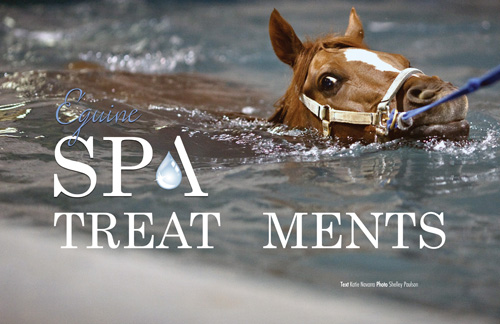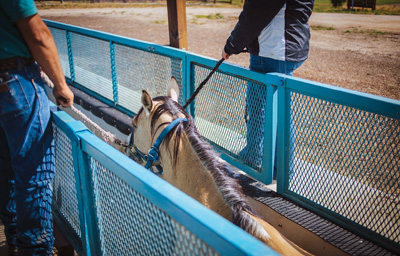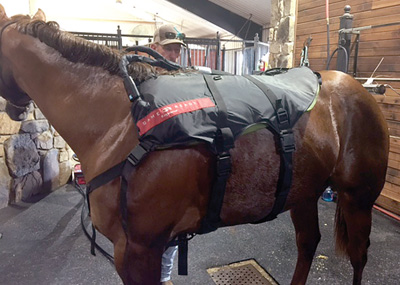 Halle Saywell’s talented Quarter Horse show partner, Gifted Invitation (Gracie) was cast in her stall one day during the 2015 Tom Powers Futurity in Michigan. In the process of getting herself free and back on her feet she suffered a serious injury to her coronet band. Over time, that progressed into a quarter crack, which eventually compromised the entire inside hoof wall of the mare’s left front hoof.
Halle Saywell’s talented Quarter Horse show partner, Gifted Invitation (Gracie) was cast in her stall one day during the 2015 Tom Powers Futurity in Michigan. In the process of getting herself free and back on her feet she suffered a serious injury to her coronet band. Over time, that progressed into a quarter crack, which eventually compromised the entire inside hoof wall of the mare’s left front hoof.
“It was difficult to keep her sound and she was tender on that hoof,” Halle said. Veterinarians continued to treat Gracie but she was still not 100 percent sound all the time. That’s when Gracie got the spa treatment.
Gifted Invitation, a 2009 sorrel mare was sent to Equisports, Inc. in Goshen, Ohio where she received a combination of spa therapies. The mare walked in the Aquapacer, an aquatic treadmill, five days a week. She was scheduled for the free walker sessions most days and stood on the EquiVibe, vibration therapy, five to seven days a week.
After two months, the mare’s hoof had healed AND she was physically fit and ready to show. The interval training that eliminated concussion on her hoof, allowed the hoof wall to regrow, while keeping her in shape and developing muscles in her topline that simply can’t be worked under saddle.
“Muscles need to contract and expand to strengthen,” said Anne Thornbury, co-owner of Equisports, Inc., “once you sit on a horse’s back, its muscles simply can’t contract. The Aquapcer in particular strengthens those muscles.”
“She looked amazing, there was a huge difference in her body condition and she was able to get back in shape without the wear and tear on her hoof,” Saywell said.
Gracie was ridden less than a week prior to the 2016 Tom Powers Futurity. Thanks to the spa treatments, Gracie and Halle found redemption at the 2016 Tom Powers Futurity, claiming a Reserve Championship in the Open Division of the Non-Pro Western Pleasure Maturity.
“Gracie was ready to go show,” Saywell said. Spa therapies aren’t only for horses in a rehabilitation program. A variety of “spa” services are ideal fitness programs too. “We have a few trainers who left horses with us this summer while other horses traveled to shows,” Thornbury said, “they wanted the horses that stayed behind to stay in shape.”
Not only are spa therapies intended to heal and designed to maintain fitness, they can also offer rejuvenation and relaxation for well-traveled horses, much like a human day spa alleviates stress and muscle soreness.
“Show schedules are grueling. Even the fittest equine athletes can suffer from sore muscles, stiffness in the joints, sustain an injury or experience performance anxiety,” said Christine Smothermon, office manager and spa technician at Equine Aqua Spa Center in Whitesboro, Texas.
 Long trailer rides to and from events can compound muscle fatigue and overall body soreness. Rehabilitation facilities have become popular layover stops for trainers and exhibitors hauling thousands of miles to show. A stop at the Equine Aqua Spa Center is a scheduled part of the trip for Halter horse trainer, Matt Henderson, of Turner-Henderson Show Horses in Albany, Oregon.
Long trailer rides to and from events can compound muscle fatigue and overall body soreness. Rehabilitation facilities have become popular layover stops for trainers and exhibitors hauling thousands of miles to show. A stop at the Equine Aqua Spa Center is a scheduled part of the trip for Halter horse trainer, Matt Henderson, of Turner-Henderson Show Horses in Albany, Oregon.
“After four days and 2,400 miles on the road, the horses get lower leg pain and stiffness from standing in the trailer,” he said, “it’s a big stress reliever for me to be able to rehab my horses so we can be competitive against people who only have a short commute to the show grounds.”
He credits much of his horses’ success at the 2015 American Paint Horse Association (APHA) World Show to the therapies his horses received during the layup.
“We left with seven World Championships and four Reserve World Championships and the layover at Equine Aqua Spa was a cornerstone to the success we had with our horses and our client’s horses,” he said.
Fortunately for trainers and riders, some of these services are also available on the road.
“Two years ago, we offered our first “mobile” services at the Palomino Horse Breeders Association (PHBA) World Championship Show and people were lining up to get horses worked on,” said Smothermon.
On the west coast, Angie Hager, owner of Eclipse Equine Sports Therapy Center in Paso
Robles, California, started setting up at cutting horse events and has since provided mobile services at reined cow horse events and a limited number of breed shows.
The spa services may vary from one facility to the next and the mobile services will likely be more limited than hauling your horse to a permanent facility.
But trainers and exhibitors who use one or more of spa services ranging from vibration therapy to cold salt water treatments, electrical stimulation, cold laser and more have witnessed how these treatments have minimized soreness, aided in recovery and eased pain in their horse’s body, which promotes better performance.
The next time you see mobile spa services available at a show you may want to consider using them if you don’t already, your horse will thank you. In the article that follows, we’ll highlight the most common therapies offered at shows, but this is by no means a comprehensive list as providers specialize in offering different services.
Vibration therapy
Plate vibration was first used to build bone density in people diagnosed with osteoporosis. Studies have proven that concussion keeps= bones and the skeletal structure strong. A vibration platform simulates concussion without the jarring of bones that occurs during exercise. Vibration stimulates circulation, which decreases inflammation.
“When a horse stands on the plate for 20 to 30 minutes, the vibration works all the way up to the withers,” Hager said.
Many trainers have invested in systems like the Theraplate or EquiVibe for daily use as part of their regular training routine. Henderson uses a Theraplate in his barn every day, but it’s just not feasible to transport the device to shows. “It’s nice to have the service on site at a show because it makes the horses feel like they are at home even when they are thousands of miles away at an event,” he said.
Vibration therapy is often used at the end of a long day to relax a horse’s stiff, sore muscles and it draws the sting out of sore hooves. Vibration increases blood and lymph flow and removes toxins and metabolic waste while stimulating and toning muscles, relaxing and building muscle tone. Though the therapy is widely known for reducing muscle soreness/inflammation, it’s also a great way to warm-up before an event.
“It can also be used as a warm up, especially when there isn’t a lot of time for warm-up, because the plate loosens the horse’s joints and muscles,” Hager said.
 Cold therapies
Cold therapies
Ice is analgesic and when alternating with pressure it helps move fluid. Cold systems help break the heat cycle and increase circulation. Mobile cold therapy systems can range from compression systems to ice boots to full sized salt water spas.
Rehabilitation centers with cold salt water spas often opt to leave the equipment at home, but Hager travels with hers and clients line up for appointments.
“When people are showing they are pushing their horses more and I found there was a really big need for the cold salt water spa at events,” she said.
Horses stand in 35 degree water for 10-12 minutes. Nearly 500 pounds of salt is added to the water and creates a strong icing poultice that draws inflammation out of the hooves and legs. The numbing effects last for four hours. “It’s really good for wounds and abscesses too,” she said.
Cold salt water spas are costly and difficult to transport and increases the maintenance needed to keep the equipment running. Rehabilitation centers that don’t own or choose not to transport a cold water spa offer other cold therapies.
Game Ready and IceVibe boots are two popular cold compressions systems that are easier to transport and more readily available at shows.
“Active compression therapy has been recognized as a superior method of eliminating swelling. The Game Ready® Equine System mirrors the way your horse’s muscles naturally contract and relax to push fluids and cellular debris (edema) into and along the lymphatic drainage system, as well as help drive cold therapy deeper for longer lasting effects,” Smothermon said.
Additional services
Depending on the equine spa that services a particular show, you may have access to a wide variety of services. “Equine chiropractic, equine bodywork, Horseware of Ireland’s Sportz-Vibe blanket are part of our mobile services,” Smothermon said, “we can also offer Human Chiropractic and limited human massage.”
When Hager sets up at events, she also offers functional electrical stimulation (FES) on a limited basis. FES treatments can penetrate up to six inches deep into the horse’s back and loosen tight muscles. It simulates a deep tissue massage and is especially beneficial for horses with neck, back and hind-end stiffness.
“I’ll only administer a half treatment at a show and only at the end of the day,” she said, “FES can loosen a muscle that’s been tight for a long period of time and we don’t want the horse to get hurt by being too loose.”
Many of the spa therapies are designed to provide non-invasive healing properties. “In the old days, when a horse had a puffy fetlock, the vet would inject it,” Henderson said, “today, we use a cold laser treatment that is not invasive and helps draw down the swelling for a couple of days.”
 Choosing services for your horse
Choosing services for your horse
Spa services are intended to refresh a tired horse and soothe sore muscles and joints. Used alone or in combination with several different treatments, horses can receive non-invasive, nonpharmaceutical therapies to help them perform at the top of their game. Hager stresses that it’s important to remember that a competition is not the time or place to make significant or drastic changes to a horse’s routine.
“The goal is to help them recover from a long day of competition, not to make significant changes,” she said.
Ideally, a horse should receive similar services at home as they will at a show. “The hardest thing to get people to understand is that it is best to treat a horse before it gets sore at a show. It’s better to be proactive, not reactive,” said Smothermon.
She encourages clients to use services from the start to the finish of an event or show. “It’s easier to prevent injuries and soreness than repair once something has happened. We find being proactive when possible is best,” she said.
Any horse, of any age, can experience relief with one or more spa services, but aged equines in particular benefit most.
“Older equine athletes are some of the biggest benefactors of our “spa” like services, as most owners feel their age, wisdom and experience make them worthy of treatments for feel good benefits,” Smothermon said.
Services and prices will vary from one venue to the next. The average cost is around $50 a day for multiple services with the opportunity to select from several packages.
“Remember, there is no one therapy or piece of equipment that fixes everything,” Hager cautioned, “if that was the case everyone would own one.”
The next time you travel to a show consider arranging for one or more spa services for your horse. Regardless of the specific services you select, your horse will recover more quickly, feel more comfortable and stay more relaxed in a hectic environment.


You must be logged in to post a comment Login